What is the zipper cut in basketball
The zipper cut consists of action that occurs when a player without the ball cuts from the low post area or the corner, generally through the lane, to the top, usually via a down screen, as a method of getting open to receive the ball.
What types of basketball positions generally use the zipper cut
The zipper cut could be carried out by any of the traditional basketball positions but it is generally used by perimeter players such as the point guard, the shooting guard, the small forward, or the combo guard.
Why is the zipper cut potentially effective
The zipper cut is potentially effective because it could be utilized primarily as an entry to implement additional offensive actions such as on-ball screens, off-ball screens, or isolation situations.
From that point, those supplementary actions could then lead to multiple scoring opportunities near the basket or near the perimeter.
As an example, let’s say that the offensive team’s best scorer, who also plays the shooting guard position, is in possession of the ball and that same player would like to utilize an on-ball screen, particularly at the top.
This could surely be achieved without the zipper cut but the problem is that the two defenders involved in that screening action (i.e. the scorer’s defender and the screener’s defender) would more than likely be prepared to defend against it, particularly with the defensive hedge tactic or the drop coverage tactic.
However, let’s say the offensive scorer utilizes the zipper cut followed by the on-ball screen. If that is the case, then that type of action is typically much more challenging to defend for both the scorer’s defender as well as the screener’s defender.
First, the scorer’s defender would have to avoid the initial down screen action to stay in front and not give up an open jump shot.
Second, even if the scorer’s defender successfully fights through the down screen, that same defender would also have to mitigate the effectiveness of the on-ball screen alongside the screener’s defender.
This could be quite an obstacle to overcome, at least with consistency, from both the scorer’s defender and the screener’s defender.
What is an example of a basic zipper cut
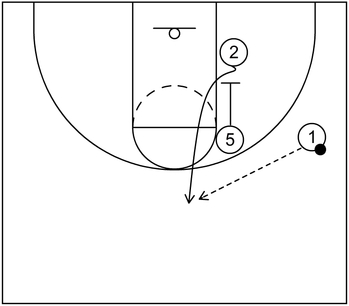
This is an example of a basic zipper cut in which 2 cuts through the lane to the top via a pin down screen set by 5. After that, 2 receives the ball from 1 and could take the open jump shot.
What are examples of simple counters for the zipper cut
Examples of simple counters that an offensive player could use if the defender attempts to mitigate or prevent the zipper cut include the backdoor cut or the fade cut.
The offensive player could use the backdoor cut if the defender implements denial defense as an tactic to mitigate the effectiveness of the zipper cut.
The offensive player could use the fade cut if the defender jumps over the top of the down screen or shoots the gap under the screen to prevent the zipper cut.
Example 1
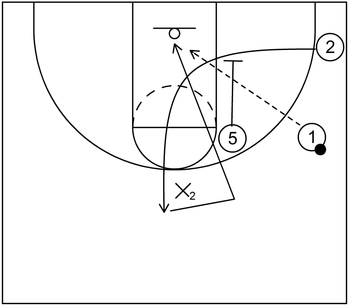
This is an example of a simple counter when X2 attempts to stop 2 from easily receiving the ball with denial defense, thus hindering the effectiveness of the zipper cut.
When that occurs, 2 executes the backdoor cut, receives the ball from 1 and scores at the rim.
Related: Denver Nuggets “Zipper Series” – YouTube
Example 2
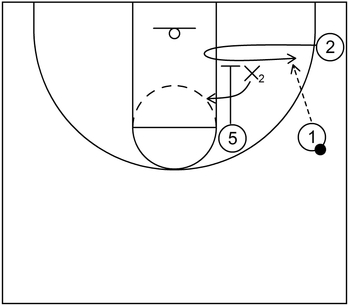
This is another example of a simple counter when X2 goes under the screen to cut off the path of 2, thus preventing the completion of the zipper cut.
When that happens, 2 could execute a fade cut towards the same corner on the right side after initially planning the zipper cut action towards the lane and then, to the top.
Following that, 2 could receive the ball from 1 and take the open mid-range or three-point jump shot.
Affiliate Disclosure: I may earn a commission on qualifying purchases made through the links below.
What is an example of an offensive set play that features the zipper cut
Part 1
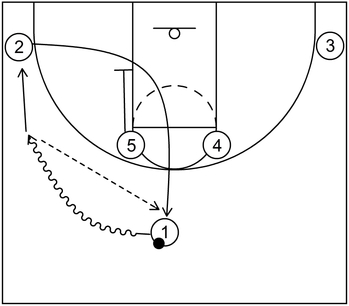
This is an example of a Horns offensive set play which features a zipper cut and additional actions to create multiple scoring options. It is derived from insights within Loop and Elbow Offenses and Counter Sets by Cheryl Reeve.
To begin, 1 executes a dribble entry towards the left side wing area and this also triggers 2 to execute a zipper cut to the top via the pin down screen set by 5.
After that, 2 receives the ball from 1 and then, 1 fills the vacated left side corner.
Part 2
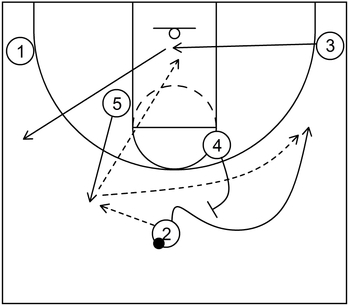
After setting the initial pin down screen, 5 pops out to the left slot area and receives the ball from 2. Immediately after 5 receives the ball, 3 cuts to the basket and hopefully seals the defender under the basket.
Once that occurs, 3 could possibly receive the ball from 5 via high low action and then quickly score around the basket.
If that option is not available, then 2 cuts toward the right side wing via the flare screen set by 4 while 3 cuts towards the left side wing area.
Next, 2 could take the three-point jump shot if that is open while 4 fills the right slot area.
Part 3
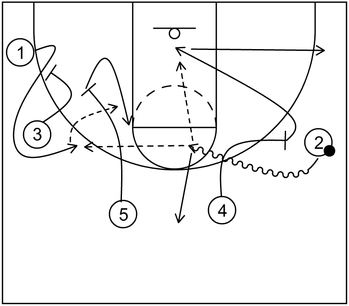
If 2 receives the ball but the jump shot is not available, then 2 could dribble towards the middle via the ball screen set by 4.
As that happens, 1 cuts to the left side wing area via the stagger screen set by 3 and 5 while 4 rolls to the basket.
Next, 4 could receive the ball and score near the rim or 1 could receive it instead and take the open jump shot. Furthermore, 2 could also take the mid-range jump shot as well if that is open.
Additionally, if 1 receives the ball from 2 but the jump shot is not there, then 5 could cut back to the left side high post elbow and receive the ball from 1.
Also, in that instance, 4 could empty out to the right side corner for optimal spacing while 2 could cut to the top as a defensive safety.
Part 4
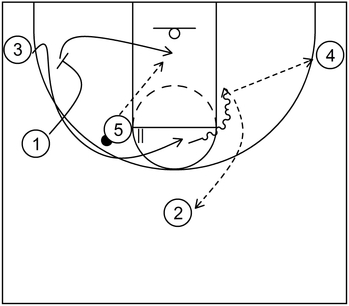
Next, 3 cuts toward 5 via a wide pin down screen set by 1 and receives the ball from 5 by way of a handoff. After that, 1 could try to get dribble penetration towards the basket and score at the rim or via a floater if necessary.
Additionally, 4 could receive the ball from 1 and take the open jump shot in the corner or 2 could receive the pitch back pass from 1 and take the jump shot as well if that is a viable option.
Also, as an alternative scoring option, when 5 is in possession of the ball, 1 could slip the screen and cut to the basket. Following that, 1 could receive the ball from 5 and score at the rim.
What are examples of basketball drills that emphasize the zipper cut
Example 1 – Part 1
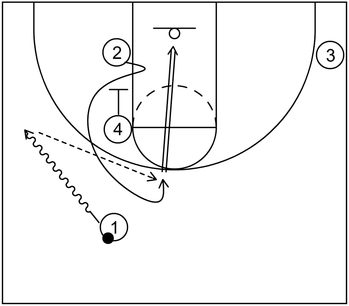
This is an example of a 4-on-0 basketball drill that emphasizes the zipper cut to create various potential scoring opportunities. It is derived from Building Your Half Court Offense with Shell Drills by Mike Procopio.
To start, 1 dribbles toward the left side wing and as that happens, 2 cuts to the top via the pin down screen set by 4. Afterwards, 2 receives the ball from 1 and takes the three-point shot.
It should also be noted that in this instance, 2 does not cut through the lane when executing the zipper cut.
Furthermore, upon receiving the ball, 2 should generally catch the ball with their back to the basket and then pivot to face up into a triple threat position.
Example 1 – Part 2
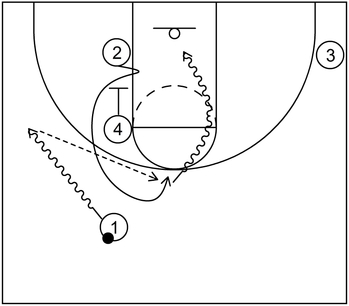
To begin this part of the drill, 1 dribbles toward the left side wing and as that occurs, 2 cuts to the top via the pin down screen set by 4. Following that, 2 receives the ball from 1 and drives to the basket to score with a layup.
Example 1 – Part 3
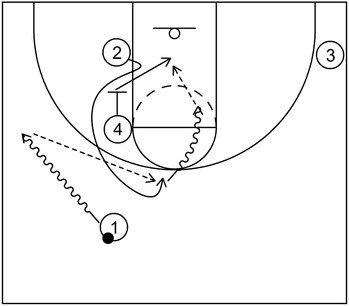
The main purpose within this part is to practice reading the defense and executing the pocket pass if the screener’s defender (i.e. X4 that would be assigned to 4) slid into the lane to provide help defense against the dribble drive action.
To initiate this part of the drill, 1 dribbles toward the left side wing and at the same time, 2 cuts to the top via the pin down screen set by 4. Next, 2 receives the ball from 1 and then gets into the lane with one or two dribbles.
As that occurs, 4 cuts into the lane, receives the ball from 2, and scores at the rim with a layup.
Example 1 – Part 4
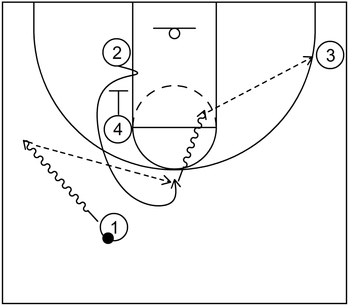
For this part of the drill, 1 dribbles to the left side wing while 2 executes the zipper cut to the top via the pin down screen set by 4. After that, 2 receives the ball from 1 and gets into the lane with one or two dribbles.
From there, 3 receives the ball from 2 and takes the open three-point jump shot.
Example 1 – Part 5
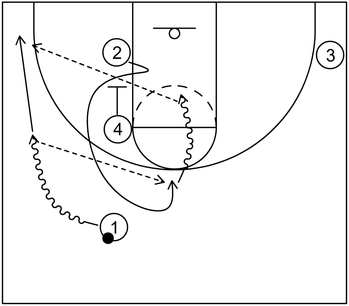
Within this part of the drill, 1 dribbles to the left side wing as 2 executes the zipper cut to the top via the pin down screen set by 4. Next, 1 begins to drift to the left side corner while 2 takes one or two dribbles into the lane.
Afterwards, 1 receives the ball from 2 and takes the open three-point jump shot.
Example 2 – Part 1
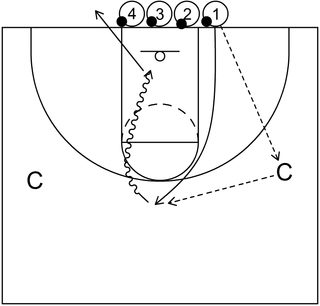
This is an example of a basketball drill that utilizes the zipper cut, albeit without the down screen. It is derived from Open Practice: Offensive and Defensive Skill Development by Larry Brown.
To set up the drill, at least two or three, but preferably four or more players will stand adjacent to each other alongside the baseline with a ball. Also, two coaches will be positioned on the high side of each wing.
To start the drill, the coach near the right side wing receives the ball from 1. Following that, 1 executes a zipper cut to the top and receives the ball again from the coach.
Next, 1 takes one or two left hand dribbles to the basket and scores at the rim with a left hand layup. After that, 1 gets the ball out of the net and moves to the back of the line behind 4.
From that point, players 2, 3, and 4 would pass the ball to the coach, execute the zipper cut, drive to the rim to score with left hand layups, get their own rebound, and move to the back of the line respectively.
Example 2 – Part 2
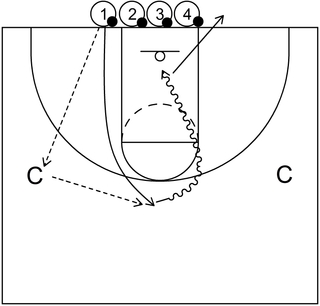
Once each player completes the drill on one side of the court, it will start again on the opposite side. Therefore, the coach on the left side wing receives the ball from 1.
After that, 1 executes the zipper cut and receives the ball again from the coach. Next, 1 takes one or two right hand dribbles to the basket and scores with a right hand layup.
From there, 1 gets the ball out of the net and moves to the back of the line behind 4. The other players will complete the drill as before on the other side of the court.
After all players finish, the drill could start over again but moving forward, the players could work on other offensive actions such as one dribble pull-ups or floaters/runners in the lane.